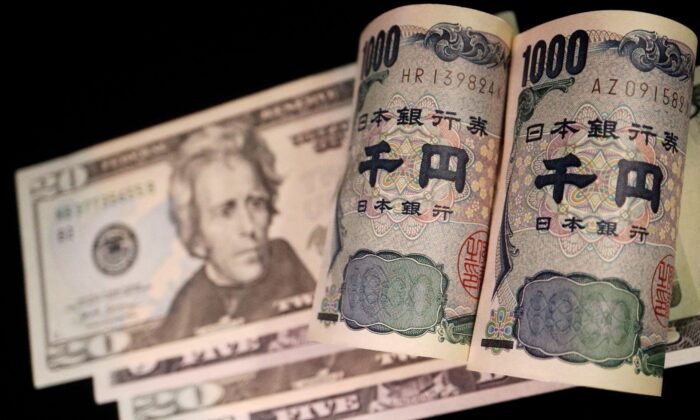Japanese Yen Hits Lowest Point in 34 Years, Dating Back to 1986
Authorities are hinting at the possibility of another round of currency-market intervention to support the yen.
The Japanese yen has recently reached its lowest level against the U.S. dollar since December 1986, leading to speculation that the government may need to intervene once again to bolster the currency and mitigate the negative impact of the significant selloff.
During the trading session on June 26, the USD/JPY exchange rate widened to around ¥160.66/$1.00, marking a nearly 14 percent decline in the yen’s value against the greenback this year. Over the past three years, the Japanese currency has also experienced a one-third devaluation.
The weakening yen has resulted in nearly a 7 percent increase in import prices in Japan over the last year, putting pressure on consumer finances and causing uncertainty for businesses.
Comments from the nation’s currency chief have raised expectations of potential action from Tokyo to support the yen, just two months after the last intervention.
“I have significant concerns about the recent sharp decline in the yen, and we are closely monitoring market trends with a heightened sense of urgency,” Vice Finance Minister Masato Kanda informed reporters on Wednesday. “We are prepared to take necessary actions against any excessive movements.”
It remains unclear at what level Japanese officials are waiting for before deciding to intervene to support the yen, according to Ipek Ozkardeskaya, a senior analyst at Swissquote Bank.
“The yen bears are testing the nerves of the Japanese officials to see what level will trigger an FX [foreign exchange] intervention,” she said in a note emailed to The Epoch Times.
Mr. Kanda’s recent remarks suggest that Japanese officials are prepared to intervene aggressively in currency markets, if required.
“Excessive currency fluctuations have a negative impact on the national economy,” Mr. Kanda stated on June 20. “In the event of excessive movements driven by speculation, we are ready to take appropriate action.”
Japanese Chief Cabinet Secretary Yoshimasa Hayashi has also indicated that authorities are ready to respond appropriately to the intense volatility in the foreign exchange rate, which has affected business and household demand.
This would not be the first time the government has intervened in the currency markets.
Following the yen’s drop to a 34-year low against the dollar in late April, Japan spent over $61 billion intervening in foreign-exchange markets between April 29 and May 29. Authorities intervened by selling the yen and purchasing other currencies, such as the U.S. dollar, in order to counter the yen’s selloff and stabilize its value.
“The intervention did not have a lasting impact,” stated Jim Bianco, the president and founder of Bianco Research.
Reading the Yen Tea Leaves
According to Michael Cahill, senior currency strategist at Goldman Sachs’ Global Macro and Markets Research Group, the yen is likely to remain at these low levels over the next six to 12 months.
“The macro environment is expected to continue weighing on this safe-haven currency, and the rate cuts from the Federal Reserve (and BOJ hikes) that we anticipate might not offer much support,” said Mr. Cahill in an email to The Epoch Times. “The yen could further weaken if the U.S. economy proves more resilient than we expect, and if the Fed delivers fewer rate cuts in the future.”

For the first time in 17 years, the Bank of Japan (BOJ) raised its key interest rate policy in March, moving from negative 0.1 percent to a range of zero percent to 0.1 percent.
Despite the rate hike in Japan, investors have not stopped pouring into dollar-denominated assets.
While the Federal Reserve has indicated its intention to reduce interest rates soon, as long as inflation pressures ease, the U.S. central bank expects to maintain the benchmark federal funds rate at a higher level for an extended period. Based on the updated June Summary of Economic Projections, Fed officials foresee only one rate cut this year, reducing the median policy rate to 5.1 percent by the end of the year, from the current range of 5.25–5.5 percent.
The Fed’s narrative of keeping rates higher for a longer period has kept U.S. Treasury yields elevated.
The 10-year yield reached over 4.31 percent on Wednesday, with the two-year yield surpassing 4.74 percent, and the 30-year bond exceeding 4.44 percent.
Mr. Bianco highlighted the importance of the relationship between the yen and the U.S. 10-year Treasury, stating that a weakening Japanese currency could drive U.S. bond yields higher.
“The correlation between the yen and the 10-year yield is not accidental,” he shared on social media. “Japan is the largest foreign holder of U.S. Treasurys, currently holding over $1 trillion, which is significantly greater than China.
The Japanese central bank has been deliberating on whether to implement another rate hike, adopting a data-dependent approach.
According to a summary of a June BOJ meeting, one monetary policymaker recommended an increase “without too much delay” to prevent inflation from exceeding expectations.
“The BOJ must continue to closely monitor data leading up to the next policy meeting,” the official stated. “If deemed appropriate, the BOJ should raise its policy rate without too much delay.”
In the previous month, Japan’s annual inflation rate rose to 2.8 percent, up from 2.5 percent in April.
Furthermore, the BOJ’s second-quarter Tankan index, which measures sentiment and outlook among large manufacturers, is set to be released on July 2, influencing officials’ next rate decision.
The next two-day BOJ policy meetings are scheduled for July 30–31.





